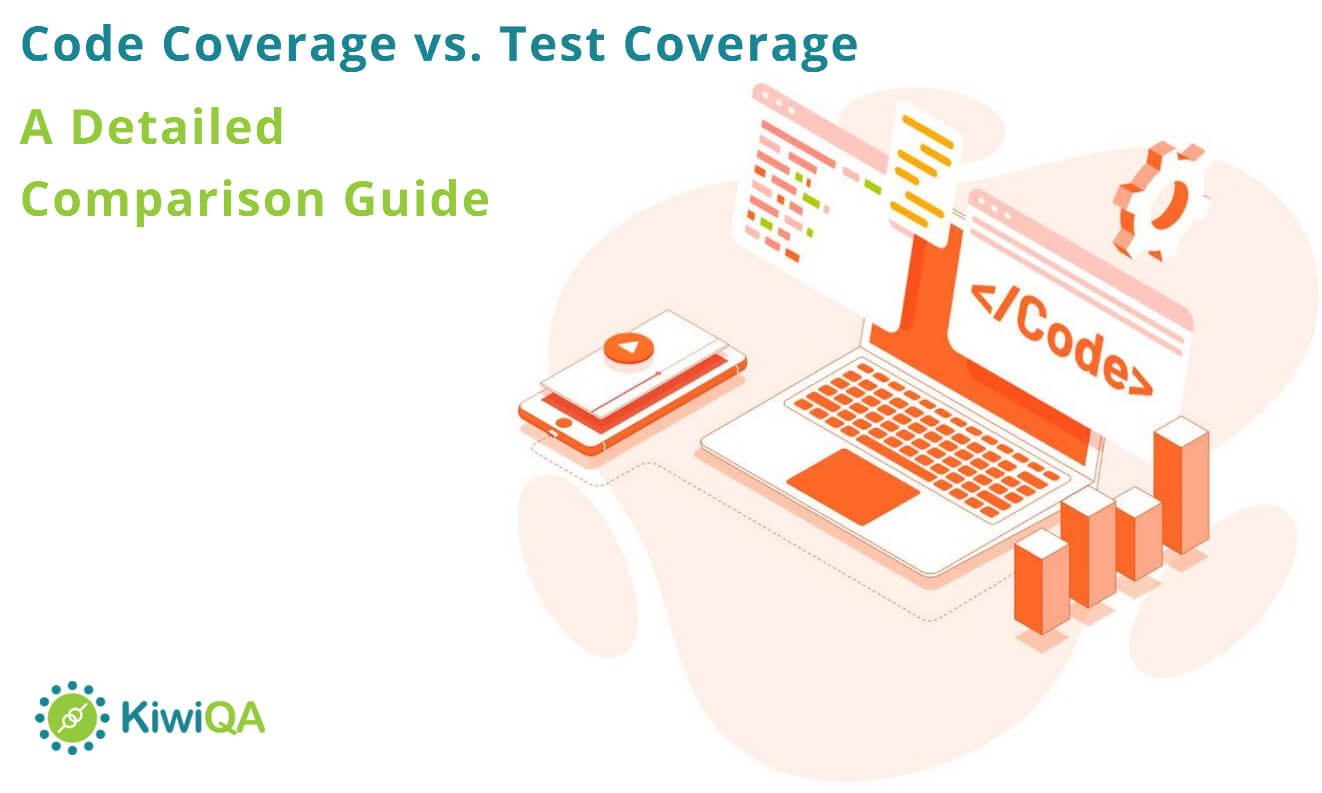Code Coverage vs. Test Coverage – A Detailed Comparison Guide

 KiwiQA
KiwiQAWhen it comes to software automation testing, coverage is a metric that should be taken on priority. Code Coverage and Test Coverage are two vital metrics that help in checking the effectiveness of the code. A large part of the testing audience uses code coverage and test coverage interchangeably. However, the fact is that there is a significant amount of difference between Code Coverage and Test Coverage.
In this blog, we deep dive into code coverage and test coverage – the two measurement metrics that are extremely important for any software product. By the end of it, you would be in a position to differentiate between the two and use relevant mechanisms to improve the product quality.
As the name indicates, code coverage indicates the percentage of code that is covered via testing (manual and automation). As a QA engineer, your constant endeavor will be to improve the test effectiveness. This is possible by improving code coverage so that exceptional quality tested code goes into the production state.
Example: Let’s assume that a code has an if..else loop. The code coverage will be 100% if the logic implemented under if & else is covered (or traversed) by the test code. On the other hand, coverage will become 50% if the logic under if (or else) is covered by the test code.
Untested code could result in quality issues. Hence, it is important to maximize the code coverage with 100% considered as the optimum coverage.
Also Read: Decoding the Difference between Robotic Process Automation and Test Automation
The features in a software product are implemented based on the requirements mentioned in the CRS (Customer Requirements Specification), SRS (Software Requirements Specification), FRS (Functional Requirements Specification), and similar requirement documents. Once the features documented in the requirements & features document are implemented, test code has to be written to verify the implemented product features.
The test encompasses different types of testing methodologies like usability testing responsive testing, cross-browser testing, and more. Test coverage is calculated based on the number of features covered by the test code.
For example – You are given the task of writing tests for verifying a login page. The test coverage should verify different conditions that might be encountered on a login page i.e. successful login, unsuccessful login, username/password left blank, etc.
More the features covered, better is the test coverage.
Unit tests are great and work well in testing the product features at a unit (or module) level. However, the code coverage will be calculated based on the tests used for verifying that unit of code. To improve the code coverage from a product standpoint, it becomes essential to solidify the test suite(s) that contain test scenarios for verifying different modules in the product.
This is possible if the test suites have tests that verify every nook and corner of the implemented code. This helps in improving the code coverage, which in turn helps in improving the code quality.
Here are the prominent forms of code coverage:
Functional Coverage– The coverage is calculated at a function (or API level). The functions should be tested against different input combinations, including those that cover boundary-level conditions.
Line (or Statement) Coverage– This type of coverage is calculated based on the tests covering executable statements in the code.
Conditional Coverage– This tests whether different conditional statements in the code are covered using relevant test code. Example – Test created for verifying a switch…case statement should traverse all the conditions implemented under switch & case
Loop Coverage– This coverage ensures that all the loops implemented in the code are tested at least once. Loops that are triggered using runtime values also have to be tested for loop coverage.
In a nutshell, higher the code coverage, lesser are the chances of customers finding bugs in your product.
Also Read: Difference between Web App Testing and Mobile App Testing
Any software product contains different blocks like UI/UX, middleware, back-end, etc. The number of blocks largely depends on the type and nature of the product. Irrespective of the complexity of the product architecture, it is imperative to test all the relevant blocks in the product.
Teat coverage will be the most optimal when performed at the block level. For example – Unit testing lets you verify the features at a unit level. On similar lines, Functional testing lets you verify the product functionalities on basis of the features mentioned in the functional specification(s).
Here are the prominent forms of test coverage:
Unit testing– Testing is performed at a module (or unit level). It only verifies the functionalities implemented in that particular module.
Integration testing– It is also referred to as system testing and tests are run at the system level. These tests can only be run when all the modules are integrated and proper communication is established between the requisite software blocks.
Acceptance testing– This is one of the most important tests on basis of which it is decided whether the product (or feature) will be released to the end-customer or not. Once the testers have done the acceptance testing, the code can be pushed from the staging environment to the production environment.
Regression testing– In regression testing, the tests that were once run on the implemented features are re-run again to ensure that the latest code implementation is not causing side-effects to an already working code.
Functional testing– Tests are derived from the features mentioned in the FRS (Functional Requirements Specification). Features are tested rigorously against those requirements.
The purpose of code coverage and test coverage is entirely different and both of them should be performed to achieve optimal product quality. While code coverage measures the percentage of code covered by the tests, test coverage covers the percentage of features that are covered through the tests.
Code coverage is primarily used for checking the effectiveness of the source code. The tools for checking code coverage vary from one programming language to another, thereby resulting in increased investments in case your team is using different programming languages.
Every code coverage tool uses different mechanisms to interpret the code, thereby making it difficult to compare code coverage captured using different tools.
Also Read: Jmeter Vs LoadRunner: Which One Is Better for Performance Testing?
Tests that are run to improve test coverage are primarily black box in nature. What this essentially means is that the tests are run keeping the features and functionalities in mind.
As a tester, you are not concerned about how the features are implemented internally in the product and the end goal is to simply verify the features of the product. The only downside of tests run to improve test coverage is that there is minimal (or no) scope of automation. Improving test coverage will require a significant investment on the resource front.
Since there is no definitive way to measure test coverage, it is left up to the competency of the tester and each tester might use a different approach to measure coverage.
You could improve test coverage of your product by utilizing software testing services from a company like KiwiQA that has experience working with a wide range of clients.
The intent of testing for improvement of code coverage and test coverage is different. Not only that, code coverage uses a white-box approach whereas test coverage uses a black-box approach.
Running code coverage tests requires a fair level of technical expertise whereas running test coverage tests requires zero (or minimal) technical know-how. Based on the project requirements, you should choose between code coverage and test coverage, though both the coverage techniques are equally important.
KiwiQA, an expert automation testing company, can add significant value by unlocking the immense benefits offered by code coverage and test coverage.
Subscribe to our newsletter for some hand-picked insights and trends! Join our community and be the first to know about what's exciting in software testing.
Welcome to the testing tales that explore the depths of software quality assurance. Find valuable insights, industry trends, and best practices for professionals and enthusiasts.

Fill out and submit the form below, we will get back to you with a plan.
 CRN:
22318-Q15-001
CRN:
22318-Q15-001 CRN:22318-ISN-001
CRN:22318-ISN-001 CRN:22318-IST-001
CRN:22318-IST-001